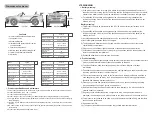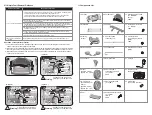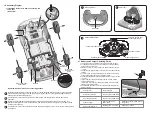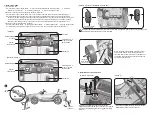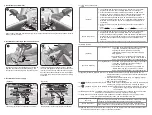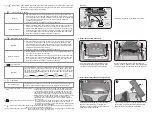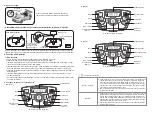
1
Key points of inspection
1) (Option A) Check if the battery is fully charged, and you can observe the display of the
central control panel to check whether the voltage is above 12V.
(Option B, Option C) Check if the battery is fully charged, and you can observe the
display panel of the central control panel to check the voltage is above 6V.
2) Check the power switch, all plugs of the dash receiver under the seat, and the battery
terminal line are properly inserted.
3) Check whether the circuit of the over-current protector is automatically disconnected
(When the motorcycle is overloaded and blocked, the circuit of the over-current protector
will be disconnected to protect the motor, dash receiver and control panel.)
4) Whether the car is stored for a long time without application and the battery is not
charged on schedule.
5) If the remote control cannot start the car, please check whether the remote control
code-matching function is normally operated.
6) Check whether the remote control battery power is low.
Check whether the battery power is enough, and charge or replace the battery if not.
Fire danger! The overcurrent
protection is only limited to 6A.
Fire danger! The overcurrent
protection is only limited to 8A.
Fire danger! The overcurrent
protection is only limited to 8A.
II. Components List
1. Car body
2. Windshield
3. Steering
Wheel
4. Rear-view mirror
5. Hand shank
6. Wheel
(Option A 2PCS)
(Option B, C 3PCS)
7. Driving wheel
(with rubber wheel
sleeve)
(Option A 2PCS)
(Option B, C 1PC)
8. Seat
9. Seat backrest
10. Tail wing
11. Front axle frame
connecting-rod
12. J-shaped stick
13. Rear wheel axle
18. Rear-view mirror screw
(3 × 12PAB)
4PCS
19. Front axle frame
connecting rod locknut
(5MM)
2PCS
20. Steering wheel locknut
(5MM)
21. Charger
22. Remote Control
(Option A, Optional B)
23. Plastic tube
(Option B, Optional C)
2
2
2
VII. Simple Fault Removal Guidance
Defective conditions
1. The car cannot be started.
2. Music sound is distorted
or silent
Operation of overcurrent protector
1) The overcurrent protector is installed under the seat. You can see it by twisting the seat screw off (As
shown in the figure) and taking the seat away.
2) When the car is overloaded, the overcurrent protector automatically disconnects the circuit (For protecting
the circuit); when the circuit fault is removed, the overcurrent protector automatically connects the circuit.
3) When the battery has power and the car can not run, please check whether the circuit of the car has an
open circuit or short circuit.
(Option A)
Battery black-plug (-)
Black
cable
Battery
red-plug (+)
Red cable
Over - current
protection
Circuit board
placing box
Warning
(Option B)
(Option C)
Battery black-plug (-)
Battery
red-plug (+)
Red cable
Black
cable
Over - current
protection
Circuit board
placing box
Battery black-plug (-)
Battery
red-plug (+)
Red cable
Over - current
protection
Control
panel box
Warning
Warning
14. Front axle frame
connecting-rod screw
(5 × 13PM)
2PCS
15. Steering wheel screw
(5 × 33PM)
16. Seat and backrest screw
(4 × 15TAB)
(D=7.5)
4PCS
17. Steering gearbox screw
(3 × 10PWAB)
(D=10)
2PCS
Black
cable


